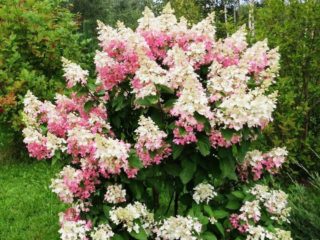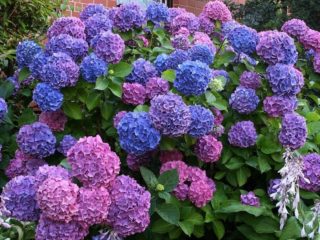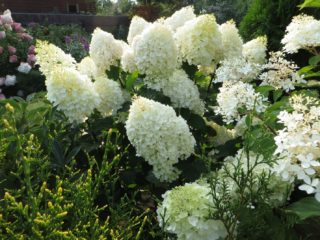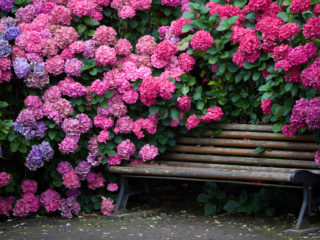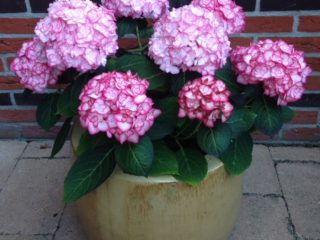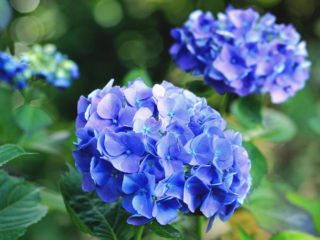Content
Household outdoor flowers are propagated according to their characteristics. Cuttings of paniculata hydrangea in summer are the easiest and most convenient way to obtain young plants of this species. If the procedure is carried out correctly, the stepsons will retain all the varietal characteristics of the mother bush.
Features of hydrangea cuttings in summer
The summer period is considered the most successful for obtaining young hydrangea plants. This is the time of laying new buds. The period of work for cuttings of hydrangea paniculata in the summer is from June 10 to July 15. This culture is best suited for this method of propagation.
For the procedure to be successful, you must follow the recommendations. They will help even a novice gardener to properly propagate a plant.
Rules for cutting hydrangea in summer:
- The parent plant is chosen to be strong, well-grown, and saturated with moisture.
- Hydrangeas of the first year of life are suitable for taking cuttings.
Young shrubs are small in size and have green stems without bark.
- If the bush is old, in the summer the young lateral stems that grew on last season's growths in the lower part of the crown are cut off.
- Select young, strong shoots with leaves and buds on which bark has not yet formed.
- For division, stems from the lower part of the bush with green, unopened buds are suitable. They shouldn't bloom.
- If there is a bud bud at the top of the shoot, it is cut off.
- Cuttings are harvested early in the morning or in cloudy weather. This way the plant tissue retains the maximum amount of necessary moisture.
- It is recommended not to cut the stem, but to pinch it off from the mother bush.
- As soon as the shoot is obtained, they immediately begin to divide it; it must not be allowed to dry out. If the procedure is planned for the next day, the stem is immersed in water.
- After planting, the cuttings take root in the second half of August.
Propagating hydrangea by cuttings in summer is the easiest and fastest way to get new flowering plants.
How to root hydrangea with cuttings in summer
At the first stage, a young and strong stem is separated from the mother bush. It should have leaves and buds.
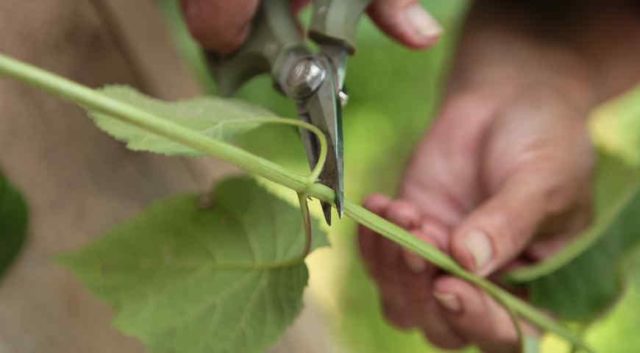
Its bottom may be a little stiff, but the top should be elastic and green
Rules for taking cuttings
Cut the stem at an angle so that the lower edge is located 2 cm below the buds, and the upper edge is 1 cm above. A step-by-step description of cuttings of paniculata hydrangea in summer is presented in the video: https://www.youtube.com/watch?v=aZ9UWJ7tcqE
After weaning the desired stem from the mother bush, they begin to divide the shoot. It is cut into cuttings of 15 cm each. The lower leaves of the shoot are removed, leaving only a couple of the upper ones.

Cuttings are shortened by half
Preparation of cuttings
The lower cut of the cutting is made oblique at an angle of 45 ᵒ, then dipped into a solution of a root formation stimulator: Kornevin, Zircon, Heteroauskin. Use them in accordance with the instructions. You can immerse the stem in Epin solution for 2 hours.
If special means are not available, the cuttings are soaked in honey water for 12 hours (1 teaspoon of sweetness per 1 glass of liquid). It is immersed in liquid by a third. Leaves should not be immersed in solutions of growth stimulants.
The upper cut of the cutting should be smooth; it is treated with a weak solution of manganese or brilliant green. This is necessary to disinfect the unprotected part of the plant.
Landing
Immediately before planting, begin preparing the soil. Its composition is as follows: 2 parts river sand and 1 part humus or garden soil. Once the mixture is ready, it must be well moistened.
The cuttings are deepened into the soil 3 cm to the first leaves, at a slight angle. The soil should be loose and moist.

The distance between plants is maintained at least 5 cm
After planting, the top layer of soil is crushed with coarse sand and sprayed with a spray bottle. The seedlings are watered with a weak solution of potassium permanganate.
Hydrangea cuttings can be done in water in summer. To do this, the cuttings are placed not in fertile soil, but in clean, clear water.
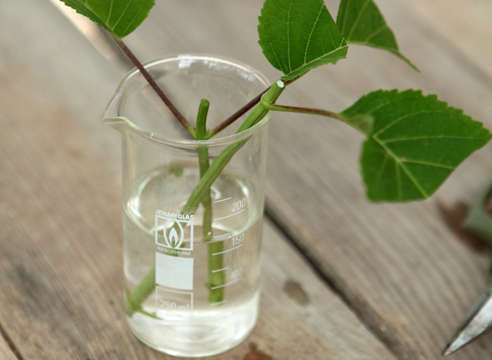
The sun's rays penetrate well through the liquid, promoting the growth of root shoots, and the process of root formation is also clearly visible
In summer, hydrangea plants are best kept indoors or in a greenhouse, shaded from direct sunlight. With the closed method of germinating cuttings, the risk of infection with garden diseases is reduced, the plant is protected from attacks by pests and sudden changes in air temperature.
The water in the container is changed 3 times a week, otherwise the process of rotting may begin. To prevent this, an activated carbon tablet is dissolved in the liquid.
Roots form in 20-30 days.
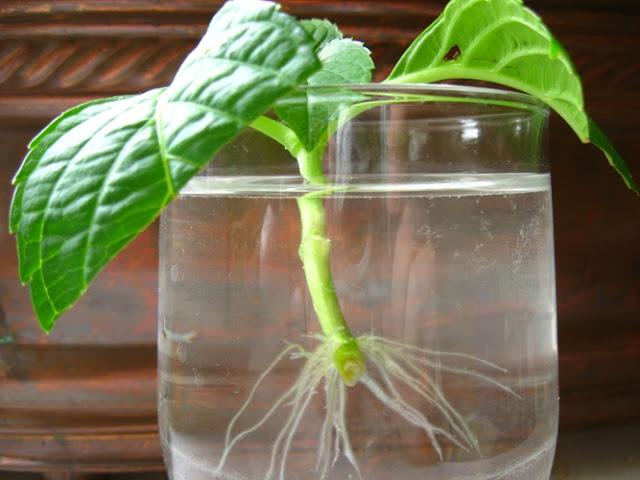
With this method of cutting hydrangeas in summer, there is a risk of seedling rotting
Surviving plants have strong immunity and tolerate temperature changes well.
Caring for cuttings
The container with planted cuttings is covered with a plastic lid or film in the summer. This technique will help create a greenhouse effect.
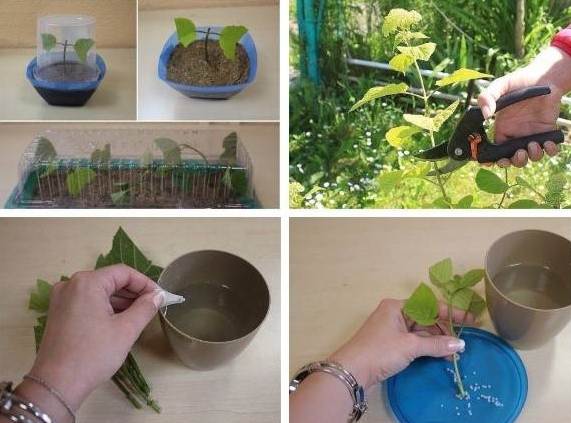
During this period, young plants require warmth and high humidity.
The optimal air temperature during the day is + 22 ᵒС, and in the evening + 18 ᵒС.
Every day, the cover is removed from the container for half an hour, ventilating the cuttings. In summer they should not be in the sun. Also, once a day, seedlings are sprayed with a spray bottle and watered with a watering can at the root. If it is not too hot outside, the amount of watering is reduced by half.
In about a month, in the summer, in mid-August, the hydrangea cuttings will take root.
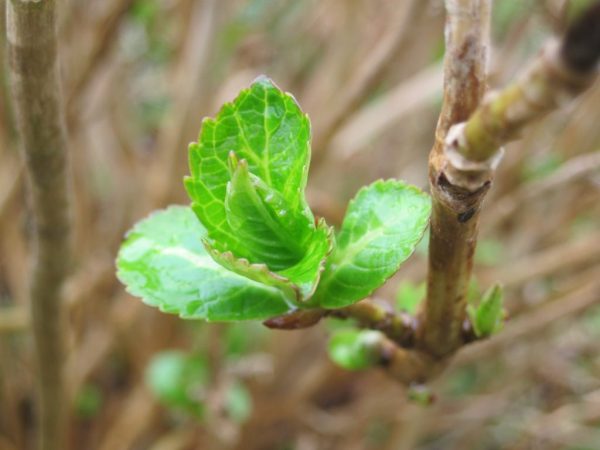
This can be determined by the young small leaves that appear at the top of the seedling
After this, the cover is removed from the container, and to accelerate growth in the summer, fertilizing is used in the form of weak solutions of nitrogen, phosphorus and potassium.
Transplantation to a permanent place
Cuttings of hydrangea in the summer in August are completed by transplanting the rooted shoots to a permanent place. As soon as the hydrangea roots grow to 3 cm, a pair of new leaves appear on the stem, the young plants are planted in separate containers.
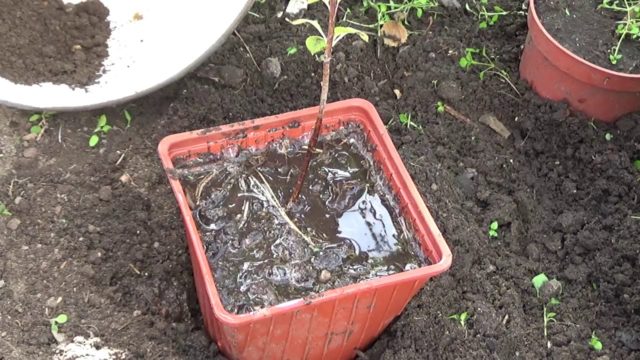
Their depth and diameter must be at least 10 cm
Watering hydrangeas in summer when cuttings are taken in July is carried out at least 2 times a week. For the winter, pots of flowers are brought into the cellar. Watering during this period is completely stopped.
You can bury a young plant in your garden plot.
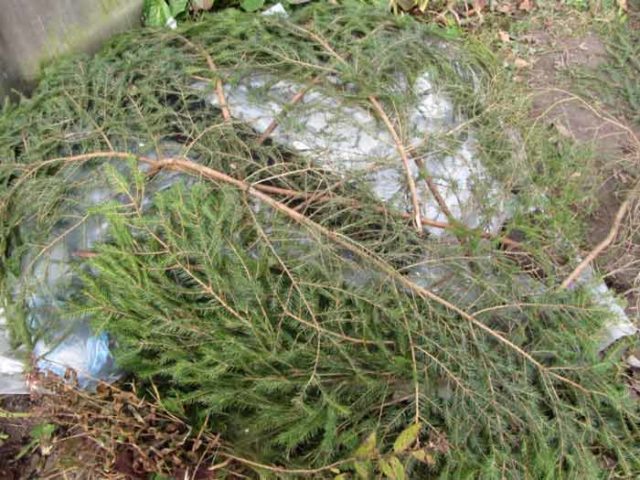
It is imperative to insulate the seedling with a heap of leaves or a spruce forest
The hydrangea is transferred to a permanent place next spring. It is first hardened by taking it outside for an hour every day.
As soon as the first leaves begin to appear, watering is resumed. After warm weather sets in outside, hydrangea cuttings are transferred to the garden. For planting, choose a place in partial shade. The bright sun is destructive for the plant, and in the shade the hydrangea buds become smaller and become faded.
The soil in the garden bed is carefully dug up. Before planting, add 1 tbsp to each hole. l. universal mineral or potassium-phosphorus fertilizer. You can purchase a special ready-made fertilizer for hydrangeas.

The hole is dug taking into account the earthen clod, along with which the flower is transferred to a permanent place
The soil is mixed with universal fertilizer 1:1 and a third of the planting hole is filled with this mixture.
Make a hole in the soil mixture for the hydrangea rhizomes. Afterwards, the plant, together with a lump of earth, is transferred to the planting hole. The root is covered with soil mixture and tamped lightly with your hands.

Then the grown hydrangea cuttings are watered
It is better to mulch the top of the soil to retain moisture.
Before planting, stop watering the grown hydrangea cuttings for a couple of days. This is necessary in order to easily remove the earthen lump from the container and transfer it to the soil.
In order for the bush to grow lush, after planting it is shortened by a third of its length.If the first buds appear on the hydrangea soon, they are cut off. This helps strengthen the root system.
Young plants are covered for winter only in the first couple of years. Older shrubs easily tolerate frost.
Conclusion
Cuttings from paniculata hydrangea in summer is the most effective way to propagate this crop. It suits almost all varieties of outdoor flowering shrubs. In the process of cuttings, you can get a large number of young, strong seedlings. They will fully retain all the varietal characteristics of the mother bush.

